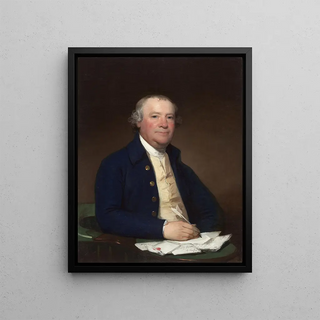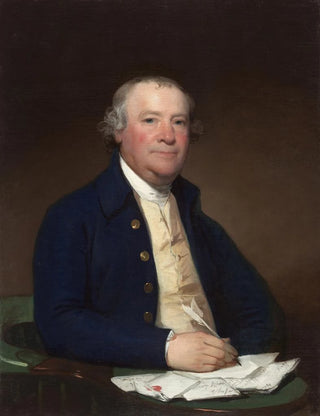Art print | Captain Joseph Anthony - Gilbert Stuart


View from behind

Frame (optional)
In the vast panorama of American art history, the art print "Captain Joseph Anthony" by Gilbert Stuart stands out for its psychological depth and striking realism. Painted at the end of the 18th century, this iconic piece demonstrates Stuart's technical mastery as well as his skill in capturing the very essence of his subjects. The portrait of Joseph Anthony, an influential businessman of the time, goes beyond a simple physical representation; it also evokes the character and personality of his model. By contemplating this art print, the viewer is invited to enter into the intimacy of its subject, to feel the emotions emanating from his gaze, and to question the stories hidden behind this face.
Style and uniqueness of the art print
Gilbert Stuart's style is undeniably marked by a realistic approach that transcends the conventions of his era. In "Captain Joseph Anthony," every detail is carefully crafted, from the textures of the clothing to the nuances of light playing on the captain's face. The artist uses a subtle color palette, where warm and cool tones blend harmoniously to create an atmosphere that is both lively and contemplative. This portrait, while rooted in a classical tradition, stands out through a modernity that foreshadows future stylistic evolutions. The composition, focused on the face of the subject, immediately draws the eye and establishes a direct connection with the viewer. This ability to forge an emotional link is one of the reasons why this art print continues to inspire and move.
The artist and his influence
Gilbert Stuart, born in 1755, is often regarded as one of the greatest American portraitists. His work not only marked his era but also set standards for future generations of artists. Stuart had the opportunity to paint major political and social figures, including the famous portrait of George Washington, which helped shape the image of the first President of the United States. His innovative approach, combining realism with psychological sensitivity, influenced many artists both in America and Europe. Through his portraits, Stuart succeeded in immortalizing personalities while endowing them with a human dimension, a characteristic

Matte finish

View from behind

Frame (optional)
In the vast panorama of American art history, the art print "Captain Joseph Anthony" by Gilbert Stuart stands out for its psychological depth and striking realism. Painted at the end of the 18th century, this iconic piece demonstrates Stuart's technical mastery as well as his skill in capturing the very essence of his subjects. The portrait of Joseph Anthony, an influential businessman of the time, goes beyond a simple physical representation; it also evokes the character and personality of his model. By contemplating this art print, the viewer is invited to enter into the intimacy of its subject, to feel the emotions emanating from his gaze, and to question the stories hidden behind this face.
Style and uniqueness of the art print
Gilbert Stuart's style is undeniably marked by a realistic approach that transcends the conventions of his era. In "Captain Joseph Anthony," every detail is carefully crafted, from the textures of the clothing to the nuances of light playing on the captain's face. The artist uses a subtle color palette, where warm and cool tones blend harmoniously to create an atmosphere that is both lively and contemplative. This portrait, while rooted in a classical tradition, stands out through a modernity that foreshadows future stylistic evolutions. The composition, focused on the face of the subject, immediately draws the eye and establishes a direct connection with the viewer. This ability to forge an emotional link is one of the reasons why this art print continues to inspire and move.
The artist and his influence
Gilbert Stuart, born in 1755, is often regarded as one of the greatest American portraitists. His work not only marked his era but also set standards for future generations of artists. Stuart had the opportunity to paint major political and social figures, including the famous portrait of George Washington, which helped shape the image of the first President of the United States. His innovative approach, combining realism with psychological sensitivity, influenced many artists both in America and Europe. Through his portraits, Stuart succeeded in immortalizing personalities while endowing them with a human dimension, a characteristic






